Many aquarium owners tend to grow many aquarium plants mainly because they absorb toxic Nitrogen compounds produced by fish waste from the water. But, many aquarium fish like to eat aquatic plants as a part of their diet. Hence the plants die after some time. On the other hand, the Pothos plant is a hard-to-kill and fast-growing plant that can do the same job that other aquarium plants can do. Because of this reason, Pothos has become a popular choice of fish tank owners all around the world.
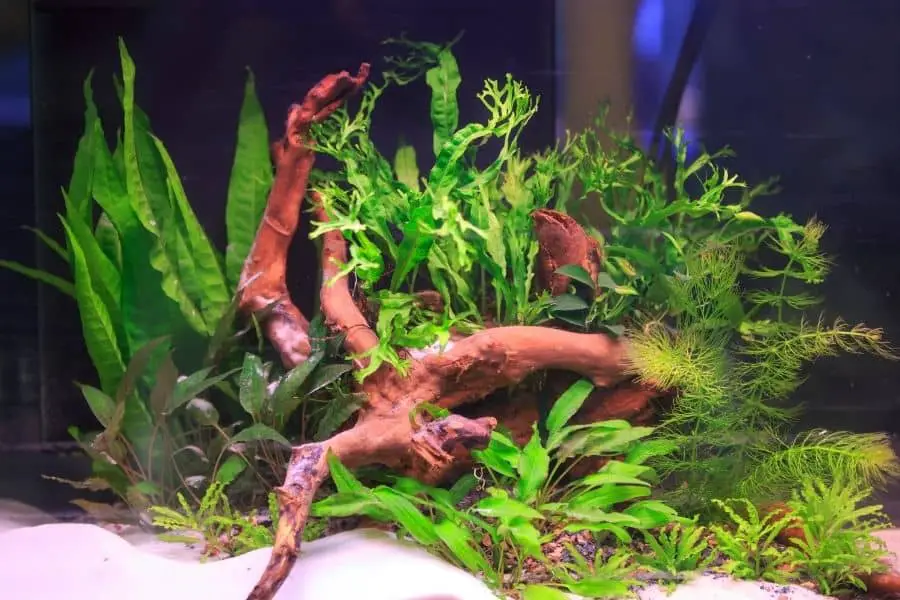
What Is Pothos?
Jump To
- 1 What Is Pothos?
- 2 Types Of Pothos
- 3 Pothos In Aquarium
- 4 Pothos in Fish Tank
- 5 What Types of Pothos Can I Grow in Aquarium or Fish Tank?
- 6 The Benefits of Pothos in Aquarium/ Fish Tank
- 7 Benefits of Pothos for Humans
- 8 Pothos Submerged In Aquarium
- 9 Is Pothos Safe for Aquariums? is pothos good for aquariums?
- 10 How Fast Does Pothos Grow?
- 11 How To Grow Pothos In Water?
- 12 Drawbacks of Keeping Pothos in Aquarium
- 13 Conclusion
Epipremnum aureum, generally known as Pothos or Devil’s Ivy, is a popular houseplant among gardeners. Pothos is an extremely hardy plant that can survive even in shallow light, nearly dark conditions.
This plant is a fast-growing plant that is very difficult to kill. You often can find Pothos in aquariums, hydroponic systems, and bioactive terrariums. Pothos is known to be toxic for house pets like dogs and cats, but there are known sources of Pothos being toxic to Aquarium pets.
Types Of Pothos
Devil’s Ivy, mostly known as Pothos, is a type of tropical vine plant with heart-shaped leaves in long trailing stems. It is an easy-to-grow plant that can grow indoors with minimum care.
There are several types of Pothos. The most common Pothos are Golden Pothos, neon pothos, pearl and jade Pothos, and marble queen pothos.
Below are ten types of Pothos you can find anywhere.
Neon Pothos
Neon Pothos has brightly-colored, almost translucent bright green leaves and a more bushy appearance than other Pothos types. This Pothos is an excellent hanging plant and can grow in water.
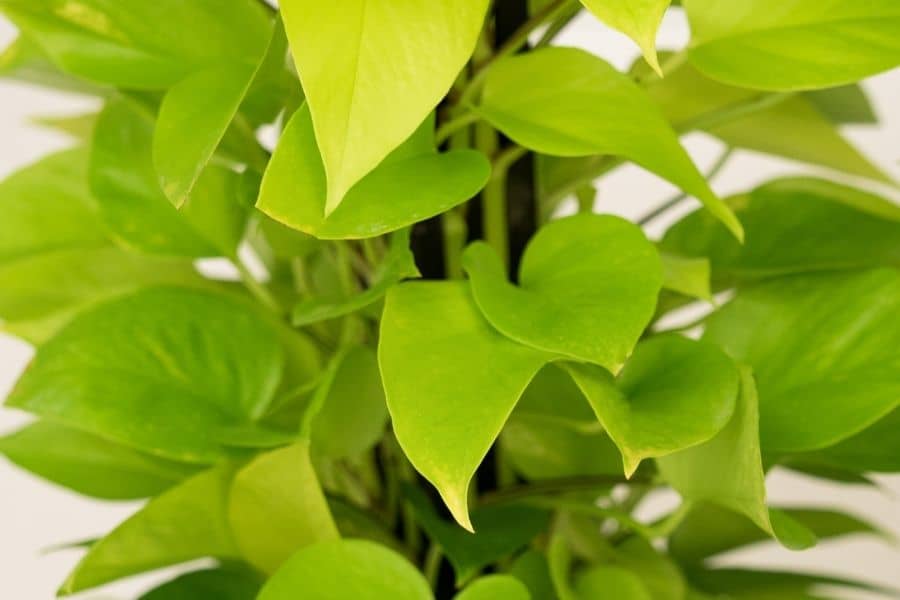
Jade Pothos
Jade pothos is the original type of Pothos that have dark green, heart-shaped leaves. This pothos is commonly called Devil’s Ivy, and it’s easy to look after.
The stems of Jade Pothos grow up to 3 feet long. This plant can be used as a hanging plant or a climbing plant and can grow in aquariums. It doesn’t need much sunlight and high humidity so, and they have a high survival rate.

Golden Pothos
Golden Pothos has light lime-colored leaves with yellow variegation, and it is considered one of the most popular types of hanging basket plants. Its shady leaf patterns are like delicate brushstrokes, which give a soft look to any dull place.
This type of Pothos can live in low light conditions and is a NASA-recommended air-purifying plant.
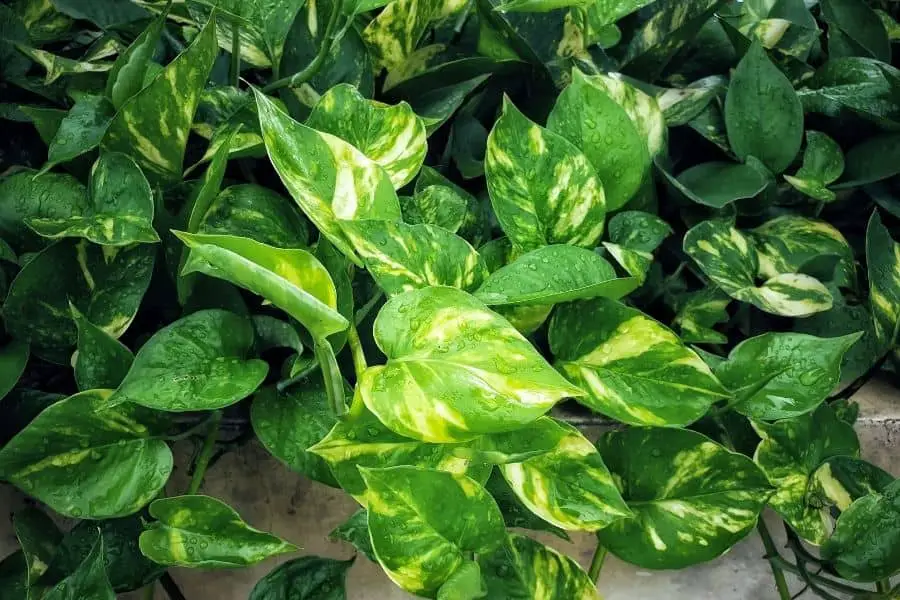
Marble Queen Pothos
Marble Queen Pothos has highly variegated leaves that are more cream-colored than green. This deep variegated plant prefers bright, indirect sunlight and has a slow growth rate.
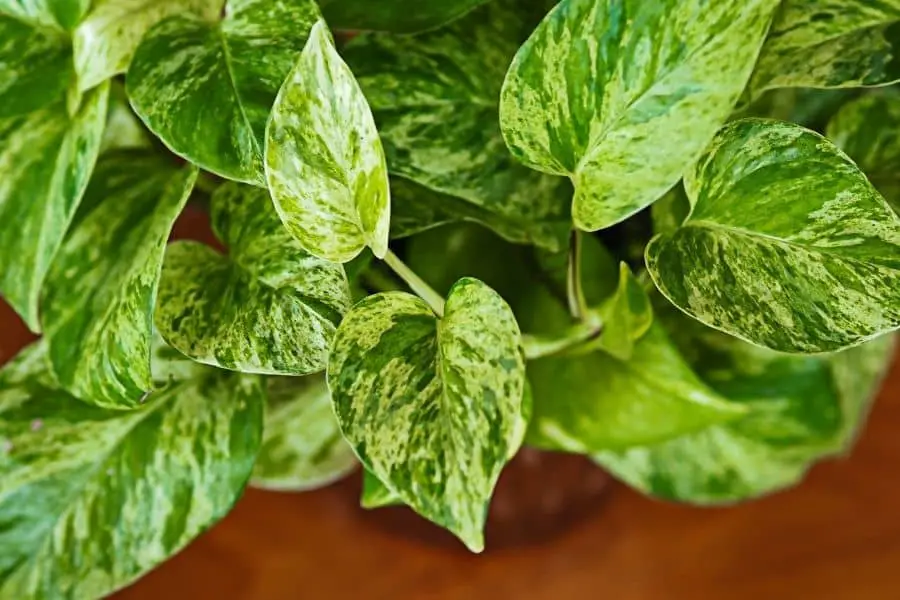
Pearls and Jade Pothos
Pearl and Jade Pothos have another nickname, “N’Joy Pothos,” as it has small-sized leaves. The leaves of this plant are emerald green with white, cream, and sometimes gray markings. This plant is a slow-growing one and needs soil to thrive, making it unsuitable for aquariums.

Hawaiian Pothos
Hawaiian Pothos has huge leaves compared to the other Pothos types and has dark green and yellow variegation.
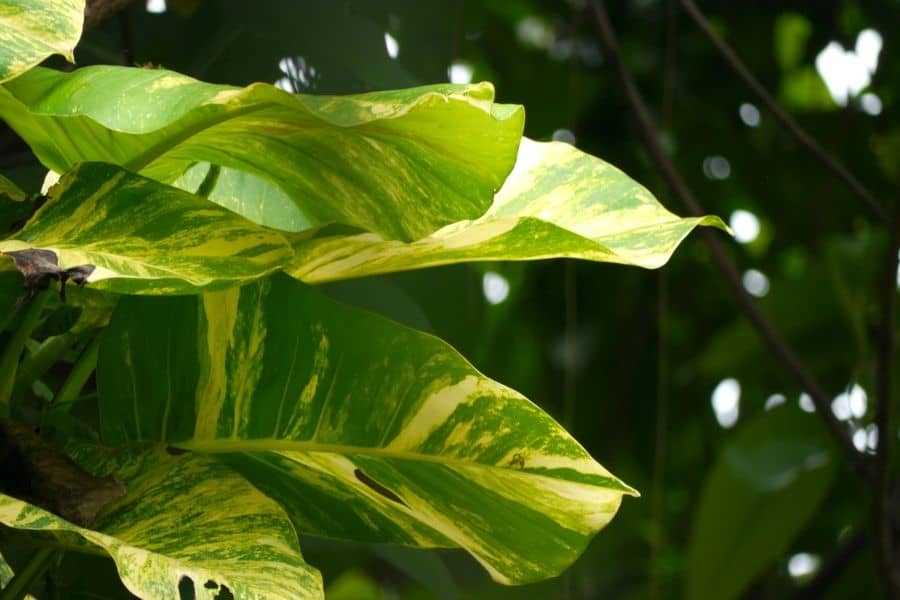
Pothos In Aquarium
Some types of Pothos can grow in water hence suitable for aquariums. Pothos is actually a house plant, so you need to keep its foliage outside the water. Taking care of Pothos in Aquarium is easy.
As Pothos is a vine plant, you can hang pothos stem anywhere outside the aquarium, keeping its root submerged in the water. It will overgrow if your aquarium has heavy bio loads and lots of fish waste.
You don’t need a massive plant in your aquarium. You can even get a plant with just a single Potho leaf, and it will readily grow roots in water.
When you buy a little plant with some established roots, make sure to wash off all the dirt and fertilizer on the roots as you don’t need any chemicals from your plant in your aquarium.
Pothos in Fish Tank
Pothos can also grow in fish tanks as fish tanks also has nutrients needed for Pothos, such as wasted food and fish poop. You need to follow exact instructions on washing off the roots explained above to keep your fish tanks’ water chemistry balanced.
What Types of Pothos Can I Grow in Aquarium or Fish Tank?
You can grow Neon Pothos, Jade Pothos, and Golden Pothos in aquariums or fish tanks. These plant types have a fast growth rate and can tolerate different light conditions.
The Benefits of Pothos in Aquarium/ Fish Tank
Keeping Pothos in Aquarium has many benefits for the ecosystem of the aquarium. Listed below are some advantages of Pothos in the Aquarium/ Fish Tank.
Removes Nitrates
Every healthy aquarium ecosystem produces Nitrate because of fish waste and other leftover foods. However, you need to remove Nitrate from the water as it is toxic for the fish.
One way to do this is to change the water regularly. The other solution is to grow Aquarium plants. Pothos plants can also remove nitrates from the water, and they are more efficient than aquarium plants.
The high growth rate of Pothos needs more Nitrogen to thrive, hence absorbing more Nitrates than other aquarium plants. So, if you want to lower the Nitrate level in your Aquarium, Pothos is a good solution.
Combat Algae
Too much light and high Nitrate levels cause algae growth in an aquarium, and getting rid of algae is really hard. If algae outcompete other aquatic plants, it can ruin your ecosystem. So, reducing algae growth is essential in any aquarium or fish tank.
You can reduce algae growth in your aquarium by using a CO2 system, controlling the light system, reducing fish food, and using RO water. Along with these steps, if you use the Pothos plant in your aquarium, it will significantly reduce Nitrate levels and help reduce Algae growth.
Provides Cover
As Pothos has a fast-growing rate, it will grow a very strong and thick root system submerged in the water. This root system is an ideal cover for fish and fry.
Gives an Awesome Look
Pothos Plant is a naturally awesome-looking plant. If you grow this plant over your aquarium, it will enhance your aquarium’s look, and it will give your fish tank a more natural look.
Omnivore Fish Proof
Omnivore fish like African Cichlids and Goldfish tend to eat aquarium plants that are submerged. They also produce lots of waste, and therefore the Nitrate levels rise very quickly.
Pothos is an excellent choice for this type of Aquariums as fish don’t bother eating roots, and Pothos grow their foliage above the water.
Benefits of Pothos for Humans
According to NASA, Pothos can remove pollutants such as benzene, toluene, formaldehyde, carbon monoxide, and xylene from the air. These air pollutants are harmful to people as well as other animals.
It can also help eliminate odors in the environment. Pothos can also help alleviate eye irritation after long days of staring at screens. Pothos is listed among the shortlist of Air-filtering plants after the NASA Clean Air Study of 1989.
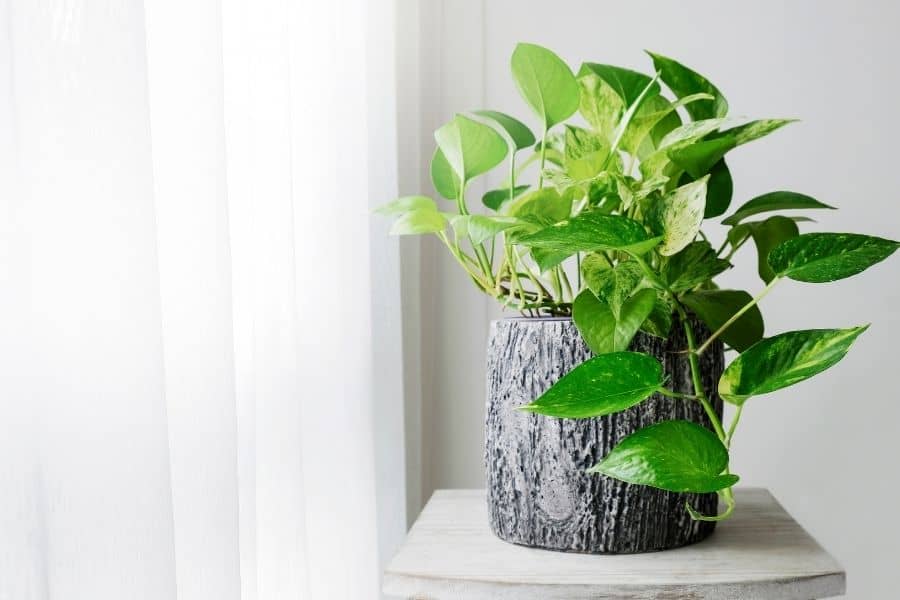
Pothos Submerged In Aquarium
Pothos is a type of Ivy. They are not aquarium plants. However, Pothos will survive fully submerged in water for some time.
The plant will eventually die if you keep its foliage submerged for an extended period. If you keep Pothos submerged in an aquarium, you will not get any of the benefits mentioned above.
Is Pothos Safe for Aquariums? is pothos good for aquariums?
Pothos is a toxic plant. But you can safely grow Pothos in Aquariums if you follow the below steps. You shouldn’t put cuttings of the Pothos directly into the tank.
Instead, you should root Pothos cuttings in water in a separate container. After the plant roots heal the cuttings, it’s safe to put them into the aquarium. Keep only pothos roots submerged in the water. You should always keep the stem and leaves above water. Or else your fish will try to eat the toxic leaves.
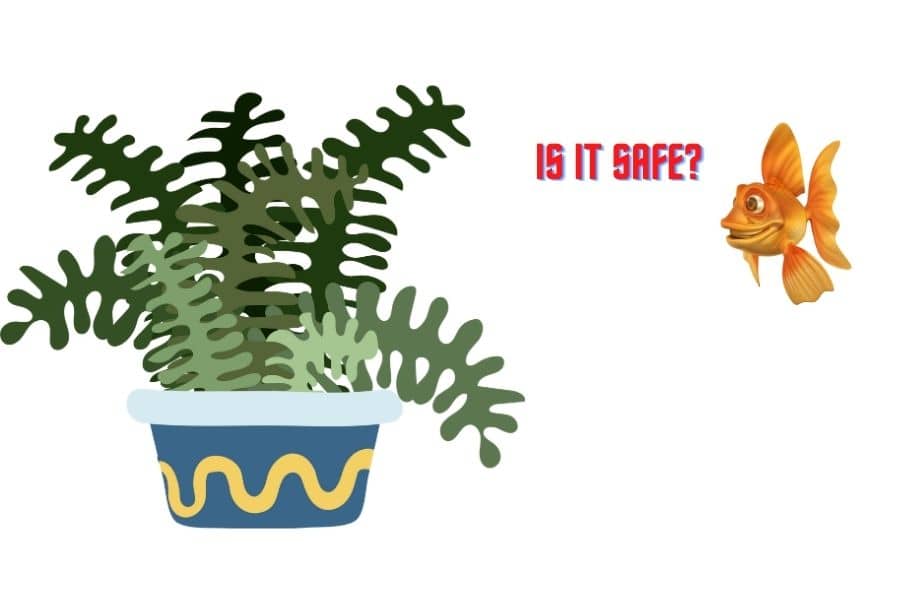
How Fast Does Pothos Grow?
If given appropriate care, Pothes can grow anywhere between 12 to 18 inches every month. The preferred temperature is 75-80°F, and the humidity level is above 70%. If the temperature drops below 70°F (21.1°C), their growth rate slows down.
How To Grow Pothos In Water?
Growing Pothos in water is tricky. You have to keep only the roots in the water. You should keep its stems and foliage above the water and change the water every 2 to 3 weeks.
You should add fertilizer every 4-6 weeks and clean algae when needed. Any fertilizer is okay for the Pothos plant.
When you grow the Pothos plant in an aquarium, you may not need to change water frequently as your aquarium’s ecosystem provides nutrients required naturally.
Providing fertilizer is also not required because the fish waste act as fertilizer for your Pothos plant.
Credit to : Lifewithpets
Drawbacks of Keeping Pothos in Aquarium
Although Pothos has many benefits for your aquarium, there are some drawbacks too. As Pothos is a fast-growing plant, it absorbs more and more nutrients from the aquarium.
At some point, when the roots of the Pothos plant become too large, it will remove all the nutrients from the water, leaving the other aquarium plants to starve to death. So, if you keep Pothos in your aquarium for a long time, many of your aquarium plants will die because of nutrient deficiency.
Another problem is Pothos is the strong root system. Its roots are thick and fast-growing, so it can take over the whole aquarium in no time.
So, you’ll have to cut the roots frequently to keep your aquarium esthetically pleasing. Pothos have insoluble calcium oxalate crystals, which are toxic for humans and pets.
If ingested, the plant will cause discomfort to your digestive tract and even your upper airway. So, it is best to keep the plant away from small children and your house pets, such as dogs and cats.
Conclusion
As you can see, Pothos has many benefits for your aquarium and you, but it can also cause a few problems. However, keeping necessary precautions in mind, growing Pothos in Aquarium is worth it in every way.
Growing Pothos in Aquarium is easy as aquariums fulfill all the Pothos plant requirements. It gives a fresh, more natural look to your aquarium even if you keep it completely submerged or emersed.
Read more: 10 Emergent Aquarium Plants for fish tank
Related: Syngonium In Aquarium | 15 Important Things To Know
